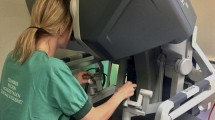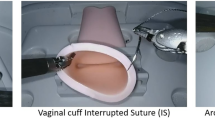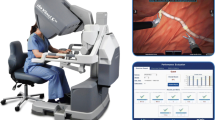Abstract
Robotic surgery is an accepted adjunct to minimally invasive surgery, but training is restricted to console time. Virtual-reality (VR) simulation has been shown to be effective for laparoscopic training and so we seek to validate a novel VR robotic simulator. The American Urological Association (AUA) Office of Education approved this study. Subjects enrolled in a robotics training course at the 2007 AUA annual meeting underwent skills training in a da Vinci dry-lab module and a virtual-reality robotics module which included a three-dimensional (3D) VR robotic simulator. Demographic and acceptability data were obtained, and performance metrics from the simulator were compared between experienced and nonexperienced roboticists for a ring transfer task. Fifteen subjects—four with previous robotic surgery experience and 11 without—participated. Nine subjects were still in urology training and nearly half of the group had reported playing video games. Overall performance of the da Vinci system and the simulator were deemed acceptable by a Likert scale (0–6) rating of 5.23 versus 4.69, respectively. Experienced subjects outperformed nonexperienced subjects on the simulator on three metrics: total task time (96 s versus 159 s, P < 0.02), economy of motion (1,301 mm versus 2,095 mm, P < 0.04), and time the telemanipulators spent outside of the center of the platform’s workspace (4 s versus 35 s, P < 0.02). This is the first demonstration of face and construct validity of a virtual-reality robotic simulator. Further studies assessing predictive validity are ultimately required to support incorporation of VR robotic simulation into training curricula.



Similar content being viewed by others

References
Watterson JD, Beiko DT, Kuan JK et al (2002) A randomized prospective blinded study validating acquisition of ureteroscopy skills using a computer based virtual reality endourological simulator. J Urol 168:1928–1932. doi:10.1016/S0022-5347(05)64265-6
Sweet R, Kowalewski T, Oppenheimer P et al (2004) Face, content and construct validity of the University of Washington virtual reality transurethral prostate resection trainer. J Urol 172:1953–1957. doi:10.1097/01.ju.0000141298.06350.4c
Rashid HH, Berkley J, Vollenweider M et al (2006) Creating a patient specific interactive virtual reality model for robotic prostatectomy. J Endourol 20((Suppl 1)):A326. doi:10.1089/end.2006.20.326
Gallagher AG, Ritter EM, Satava RM (2003) Fundamental principles of validation, and reliability: rigorous science for the assessment of surgical education and training. Surg Endosc 17:1525–1529. doi:10.1007/s00464-003-0035-4
Seymour NE, Gallagher AG, Roman SA et al (2002) Virtual reality training improves operating room performance: results of a randomized, double-blinded study. Ann Surg 236:458–463. doi:10.1097/00000658-200210000-00008
Korndorffer JR Jr, Dunne JB, Sierra R et al (2005) Simulator training for laparoscopic suturing using performance goals translates to the operating room. J Am Coll Surg 201:23–29. doi:10.1016/j.jamcollsurg.2005.02.021
Lin DW, Romanelli JR, Thompson RE et al (2007) Computer-based laparoscopic and robotic surgical simulators: performance characteristics and perceptions of new users, SAGES Meeting Abstract S077: robotics
Gunther S, Rosen J, Hannaford B et al (2007) The red DRAGON: a multi-modality system for simulation and training in minimally invasive surgery. Stud Health Technol Inform 125:149–154
Figert PL, Park AE, Witzke DB et al (2001) Transfer of training in acquiring laparoscopic skills. J ACS 193:533
Gallagher AG, Ritter EM, Champion H et al (2005) Virtual reality simulation for the operating room: proficiency-based training as a paradigm shift in surgical skills training. Ann Surg 241:364–372. doi:10.1097/01.sla.0000151982.85062.80
Hassan I, Maschuw K, Rothmund M et al (2006) Novices in surgery are the target group of a virtual reality training laboratory. Eur Surg Res 38:109–113. doi:10.1159/000093282
Acknowledgments
We would like to thank the AUA Office of Education for allowing us to perform this study. We give special thanks to Intuitive Surgical and MIMIC Technologies, Inc. for providing us with da Vinci robots and the VR platforms, respectively.
Author information
Authors and Affiliations
Corresponding author
Rights and permissions
About this article
Cite this article
Lendvay, T.S., Casale, P., Sweet, R. et al. Initial validation of a virtual-reality robotic simulator. J Robotic Surg 2, 145–149 (2008). https://doi.org/10.1007/s11701-008-0099-1
Received:
Accepted:
Published:
Issue Date:
DOI: https://doi.org/10.1007/s11701-008-0099-1



